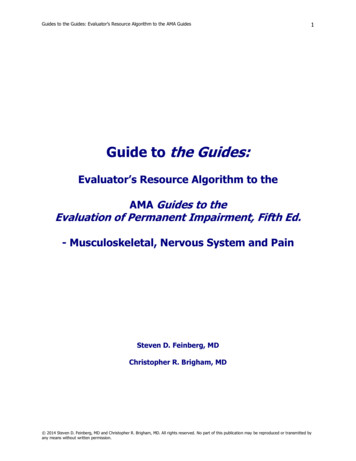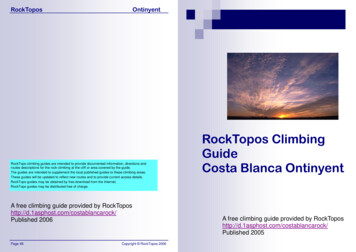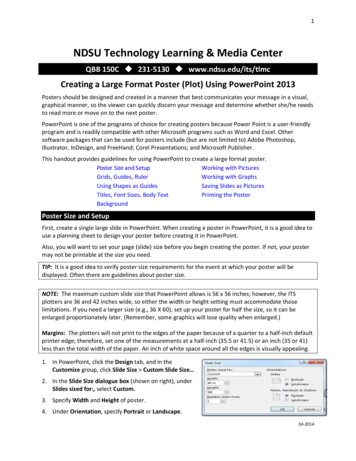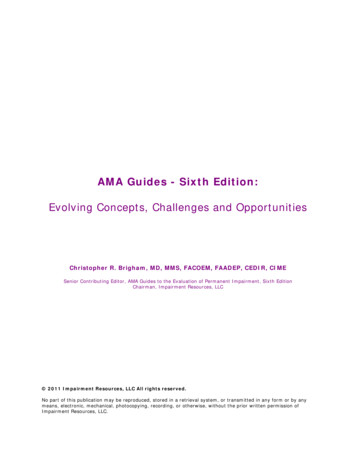
Transcription
Guides to the Guides: Evaluator’s Resource Algorithm to the AMA Guides1Guide to the Guides:Evaluator’s Resource Algorithm to theAMA Guides to theEvaluation of Permanent Impairment, Fifth Ed.- Musculoskeletal, Nervous System and PainSteven D. Feinberg, MDChristopher R. Brigham, MD 2014 Steven D. Feinberg, MD and Christopher R. Brigham, MD. All rights reserved. No part of this publication may be reproduced or transmitted byany means without written permission.
Guides to the Guides: Evaluator’s Resource Algorithm to the AMA Guides2This book is for information purposes only. It is not intended to constitute medical, legal or financial advice. Ifmedical, legal, financial, or other professional advice is required, the services of a competent professional should besought.No part of this publication may be reproduced, storied in a retrieval system, or transmitted in any form or by anymeans, electronic, mechanical, photocopying, recording, or otherwise, without the prior written permission of theauthors. 2014 Steven D. Feinberg, MD and Christopher R. Brigham, MD. All rights reserved. No part of this publication may be reproduced or transmitted byany means without written permission.
Guides to the Guides: Evaluator’s Resource Algorithm to the AMA Guides3PrefaceThis resource is designed to simplify use of the AMA Guides to the Evaluation of Permanent Impairment andimprove the accuracy of ratings. The reality is that there is no easy way to learn the AMA Guides but this is anapproach at perhaps making it a little simpler. It is critical that you keep the AMA Guides 5th Edition available asyou review this resource. We have provided you with a format such that if the examiner answers the questions andfills out the integrated fill-in squares and check off boxes, the examiner should at least identify and address allpossible issues for an AMA Guides impairment evaluation. We welcome your feedback.AuthorsSteven Feinberg, MDFeinberg Medical Group, 825 El Camino Real, Palo Alto, CA 94301; 650-223-6400; stevenfeinberg@hotmail.com;www.FeinbergMedical Group.comAmerican Board of Pain Medicine, American Board of Electrodiagnostic Medicine, American Board of PhysicalMedicine & Rehabilitation, Qualified Medical Evaluator, Adjunct Clinical Professor, Stanford University School ofMedicine, and Medical Director of Cedaron AMA Guides Impairment Rating software. Dr. Feinberg served on theACOEM Chronic Pain Guidelines Panel Chapter Update and also as Associate Editor, as a Medical Reviewer for theACOEM 2014 Opioid Guidelines and he also serves ongoing as a Medical Consultant to the Official DisabilityGuidelines (ODG) and on the Reed Group’s Medical Advisory Board. He served as a Reviewer for the AMA Guidesto the Evaluation of Permanent Impairment, 6th Edition.Christopher R. Brigham, MDPresident, Brigham and Associates, Inc., Brigham and Associates, Inc., Pali Palms Plaza, Suite C312, 970 NorthKalaheo Avenue, Kailua, HI 96734, 808-254-9400; cbrigham@cbrigham.com; https://www.cbrigham.comAmerican Board of Preventive Medicine – Occupational Medicine, Fellow American Academy of DisabilityEvaluating Physicians and Certification in Evaluation of Disability and impairment rating, Fellow American Collegeof Occupational and Environmental Medicine, Certified Independent Medical Examiner and Founder of AmericanBoard of Independent Medical Examiners, Editor-in-chief of the AMA Guides Newsletter and Guides Casebook andwas co-author of Understanding the AMA Guides in Workers’ Compensation. He is the Senior Contributing Editorfor the AMA Guides to the Evaluation of Permanent Impairment, Sixth Edition, and was a contributor/author for themusculoskeletal chapters. For the Fifth Edition, he served on the Advisory Committee and as a contributor. 2014 Steven D. Feinberg, MD and Christopher R. Brigham, MD. All rights reserved. No part of this publication may be reproduced or transmitted byany means without written permission.
Guides to the Guides: Evaluator’s Resource Algorithm to the AMA Guides4Table of ContentsPREFACE 3AUTHORS 3TABLE OF CONTENTS 4ORIENTATION 4CHAPTER 13 – THE CENTRAL AND PERIPHERAL NERVOUS 6CHAPTER 15 – THE SPINE 18CHAPTER 16 – THE UPPER EXTREMITIES 30CHAPTER 17 – THE LOWER EXTREMITIES 51CHAPTER 18 – PAIN 71INDEX 73OrientationThe AMA Guides to the Evaluation of Permanent Impairment, Fifth Edition is the standard for rating impairment.Physicians and others are trying to learn it and then apply it in a fair and equitable manner.It is imperative that the physician understand and follow the principles of the Guides. Chapter 1 Philosophy, Purposeand Appropriate Use of the Guides and Chapter 2 Practical Applications of the Guides define standards that apply toall ratings. The individual chapters define principles of assessment and the rating process.Maximal Medical Improvement (MMI) or Permanent and Stationary(P&S)The examinee must be at maximal medical improvement (MMI), the equivalent of Permanent and Stationary(P&S), to produce an impairment rating. It is necessary to determine that the patient is stable, and that no furtherrestoration of function is probable. If the examinee shows up and is in the middle of a flare-up or has had a newinjury that interferes with the examination, it is premature to do an impairment rating. In other words, the examineemust be stabilized medically for the physician to fairly assess the impairment rating. If the condition is changing orlikely to improve substantially with medical treatment, the impairment is not permanent and should not be rated. Forexample, an examinee has a known industrial injury problem, but the day before the examination is in an autoaccident and has increased complaints. An impairment rating examination that is a fair representation of theexaminee at MMI status in this situation cannot be done. Assuming the examinee has reached MMI and is nothaving a flare-up or other problem, the physician can go forward with the impairment rating. 2014 Steven D. Feinberg, MD and Christopher R. Brigham, MD. All rights reserved. No part of this publication may be reproduced or transmitted byany means without written permission.
Guides to the Guides: Evaluator’s Resource Algorithm to the AMA Guides5Activities of Daily Living (ADL)Impairment percentages or ratings are estimates that reflect the severity of the medical condition and the degree towhich the impairment decreases an individual’s ability to perform common activities of daily living (ADL),excluding work. Throughout the AMA Guides, the examiner is given the opportunity to adjust the ImpairmentRating based on the extent of any ADL deficits (5th ed., Table 1-2, 4). The following are typical ADLs. Self-care & personal hygiene– Urinating, defecating, brushing teeth, combing hair, bathing, dressing oneself, eatingCommunication– Writing, typing, seeing, hearing, speakingPhysical activity– Standing, sitting, reclining, walking, climbing stairsSensory function– Hearing, seeing, tactile feeling, tasting, smellingNonspecialized hand activities– Grasping, lifting, tactile discriminationTravel– Riding, driving, flyingSexual function– Orgasm, ejaculation, lubrication, erectionSleep– Restful, nocturnal sleep pattern 2014 Steven D. Feinberg, MD and Christopher R. Brigham, MD. All rights reserved. No part of this publication may be reproduced or transmitted byany means without written permission.
Guides to the Guides: Evaluator’s Resource Algorithm to the AMA Guides6Chapter 13 – The Central and Peripheral Nervous SystemOverviewThis chapter provides criteria for evaluating permanent impairments due to documented dysfunction of the brain,cranial nerves, spinal cord, nerve roots, and/or peripheral nerves and muscles. It is comprised of the followingsections:13.1Principles of Assessment13.2Criteria for Rating Impairments Due to Central Nervous System Disorders13.3Criteria for Rating Cerebral Impairments13.4Criteria for Rating Impairments of the Cranial Nerves13.5Criteria for Rating Impairments of Station, Gait, and Movement Disorders13.6Criteria for Rating Impairments of Upper Extremities Related to Central Impairment13.7Criteria for Rating Spinal Cord and Related Impairments13.8Criteria for Rating Impairments Related to Chronic Pain13.9Criteria for Rating Impairments of the Peripheral Nervous System, Neuromuscular Junction, andMuscular System13.10 Nervous System Impairment Evaluation SummaryCriteria for Rating Impairment Due to Central Nervous SystemDisordersRatings are provided only for documented central nervous system dysfunction, when at maximum medicalimprovement. This section is not used solely for subjective complaints.The following are considered in rating central nerve system disorder impairment, as explained in Sections 13.2 (5thed., 308) and 13.3 (5th ed., 309-327)(1) State of consciousness and level of awareness, whether permanent or episodic;a. See Table 13-2 (5th ed., 309), (Criteria for Rating Impairment of Consciousness and Awareness 13.3a (5th ed., 309);b. Table 13-3 (5th ed., 312), (Criteria for Rating Impairment Due to Episodic Loss of Consciousnessor Awareness – 13.3b (5th ed., 311); andc. Table 13-4 (5th ed., 317), (Criteria for Rating Impairment Due to Sleep and Arousal Disorders –13.3c (5th ed., 317).(2) Mental status evaluation and integrative functioning - 13.3d (5th ed., 319);a. Table 13-6 (5th ed., 320), Criteria for Rating Impairment Related to Mental Status.(3) Use and understanding of language – 13.3e (5th ed., 322); anda. Table 13-7 (5th ed., 323), Criteria for Rating Impairment Due to Aphasia or Dysphasia.(4) Influence of behavior and mood – 13.3f (5th ed., 325).a. Table 13-8 (5th ed., 325), Criteria for Rating Impairment Due to Emotional or BehavioralDisorders 2014 Steven D. Feinberg, MD and Christopher R. Brigham, MD. All rights reserved. No part of this publication may be reproduced or transmitted byany means without written permission.
Guides to the Guides: Evaluator’s Resource Algorithm to the AMA Guides7Step #1: Each AMA Guides Table (13-2, 3, 4, 6, 7, 8 - see below for page numbers) has a description and it is yourtask to pick the category that best fits the impairment. Each category has a percentage range as well and the numberyou choose should be a function of whether the impairment is closer to the category above or below and how ADLsare affected (the greater ADL loss, the higher the range).When you have considered the 4 categories, fill in the following Criteria for Rating Cerebral Impairments Form.You need to identify the most severe cerebral impairment from these four categories to be used to determine acerebral impairment rating. There may be impairment in all four categories but you only take the highest impairmentrating from the most severe category.Criteria for Rating Cerebral Impairments Form (Tables (13-2, 3, 4, 6, 7, 8 - see below for page numbers)WPI Percentage1. State of consciousness and level of awareness, whether permanent or episodicImpairment of Consciousness and Awareness (page 309)Impairment Due to Episodic Loss of Consciousness or Awareness (page 312)Impairment Due to Sleep and Arousal Disorders (page 317)2. Mental status evaluation and integrative functioningImpairment Related to Mental Status (page 320)3. Use and understanding of languageImpairment Due to Aphasia or Dysphasia (page 323)4. Influence of behavior and moodImpairment Due to Emotional or Behavioral Disorders (page 325)Highest impairment rating from the most severe categoryTable 13-2 State of consciousness and level of awareness, whether permanent or episodic (5th ed., 309)Table 13-3 Criteria for Rating Impairment Due to Episodic Loss of Consciousness or Awareness (5th ed., 312)Table 13-4 Criteria for Rating Impairment Due to Sleep and Arousal Disorders (5th ed., 317)Table 13-5 Clinical Dementia Rating (CDR) (5th ed., 320)Note: To use the CDR, score the individual’s cognitive function for each category (M, O, JPS, CA, HH,and PC) independently. The maximum CDR score is 3. Memory is considered the primary category; theother categories are secondary. If at least three secondary categories are given the same numeric score asmemory, then CDR M. If three or more secondary categories are given a score greater or less than thememory score, CDR the score of the majority of secondary categories unless three secondary categoriesare scored on one side of M and two secondary categories are scored on the other side of M. In this case,CDR M.Table 13-6 Criteria for Rating Impairment Related to Mental Status (5th ed., 320)Table 13-7 Criteria for Rating Impairment Due to Aphasia or Dysphasia (5th ed., 323)Table 13-8 Criteria for Rating Impairment Due to Emotional or Behavioral Disorders (5th ed., 325) 2014 Steven D. Feinberg, MD and Christopher R. Brigham, MD. All rights reserved. No part of this publication may be reproduced or transmitted byany means without written permission.
Guides to the Guides: Evaluator’s Resource Algorithm to the AMA Guides8Step #2: Your next task is to combine the most severe impairment from categories 1 through 4 from the Criteria forRating Cerebral Impairments Form that you just completed with any or multiple distinct neurologic impairmentslisted in Table 13-1 (5th ed., 308, using the Combined Values Chart, p. 604. The distinct neurologic impairments areas follows: Cranial nerve impairmentsStation, gait, and movement disordersExtremity disorders related to central impairmentSpinal cord impairmentsChronic painPeripheral nerve, motor, and sensory impairmentsCriteria for Rating Impairments of the Cranial NervesCriteria for Rating Impairments of the Cranial Nerves – 13.4 (5th ed., 327)WPII—the Olfactory Nerve – 13.4a (5th ed., 327)II—the Optic Nerve – 13.4b (5th ed., 327)III, IV, and VI—the Oculomotor, Trochlear, and Abducens Nerves -13.4c (5th ed., 330)V—the Trigeminal Nerve – 13.4d (5th ed., 330)VII—the Facial Nerve – 13.4e (5th ed., 332)VIII—the Vestibulocochlear Nerve – 13.4f (5th ed., 333)IX and X—the Glossopharyngeal and Vagus Nerves – 13.4g (5th ed., 334)XI—the Spinal Accessory Nerve – 13.4h (5th ed., 334)XII—the Hypoglossal Nerve – 13.4i (5th ed., 334)Combine all of the above using the CVC I—the Olfactory Nerve – 13.4a (5th ed., 327) (circle only one)1%2%3% II—the Optic Nerve – 13.4b (5th ed., 327) (fill in %):% III, IV, and VI—the Oculomotor, Trochlear, and Abducens Nerves -13.4c (5th ed., 330) (fill in %) (also seeChapter 12).% V—the Trigeminal Nerve – 13.4d (5th ed., 330) (fill in %).% VII—the Facial Nerve – 13.4e (5th ed., 332) (fill in %).% 2014 Steven D. Feinberg, MD and Christopher R. Brigham, MD. All rights reserved. No part of this publication may be reproduced or transmitted byany means without written permission.
Guides to the Guides: Evaluator’s Resource Algorithm to the AMA Guides 9VIII—the Vestibulocochlear Nerve – 13.4f (5th ed., 333) (fill in %).% IX and X—the Glossopharyngeal and Vagus Nerves – 13.4g (5th ed., 334) (fill in %).% XI—the Spinal Accessory Nerve – 13.4h (5th ed., 334) (fill in %).o Is Voice/Speech impaired? Go to ENT Chapter (Table 11.8) to enter Voice impairment.o Is Head Turning Impaired? Use Cervical ROM Method in Spine Chapter.o Is Shoulder Motion Impaired? Use Upper Extremity Chapter for Shoulder% XII—the Hypoglossal Nerve – 13.4i (5th ed., 334) (fill in %).%Criteria for Rating Impairments of Station, Gait, and MovementDisorders (remember you are in Chapter 13 and an Impairment should involve The Central andPeripheral Nervous System)Criteria for Rating Impairments of Station, Gait, and Movement Disorders – 13.5 (5th ed., 336) Problems maintaining balance and a stable GAIT can develop from a CNS or peripheral neurologicimpairment. Impairment ratings for station and gait disorders are determined according to the effect onambulation (see Table 13-15 (5th ed., 336) (fill in %).GAIT%MOVEMENT DISORDERS are assessed for their interference with ADLs as described for the lower extremitiesin Tables 13-15 (5th ed., 336, for one upper extremity in Table 13-16 (5th ed., 338, and for two upper extremities inTable 13-17, 340.o MOVEMENT DISORDERS Lower extremities % One upper extremity % Two upper extremities % Use the CVC Table (5th ed., 602) (fill in %).% 2014 Steven D. Feinberg, MD and Christopher R. Brigham, MD. All rights reserved. No part of this publication may be reproduced or transmitted byany means without written permission.
Guides to the Guides: Evaluator’s Resource Algorithm to the AMA Guides10Criteria for Rating Impairments of Upper Extremities Related toCentral Impairment (remember you are in Chapter 13 and an Impairment should involve TheCentral and Peripheral Nervous System)Criteria for Rating Impairments of Upper Extremities Related to Central Impairment – 13.6 (5th ed., 338) Use Tables 13-16 (5th ed., 338), for one extremity and Table 13-17 (5th ed., 340), for involvement of bothupper extremities for rating upper extremity dysfunction from any lesion in the brain manifested byweakness, tremor, or pain that affects ADL.o One Extremity %o Two Extremities %%Criteria for Rating Spinal Cord and Related Impairments (remember you arein Chapter 13 and an Impairment should involve The Central and Peripheral Nervous System such aswith a spinal tumor or other spinal cord insult but if there is an associated Spine (bone) injury, thenChapter 15, The Spine, should be used with the DRE Method combining the corticospinal “spinal cord”impairment in that Chapter)Criteria for Rating Spinal Cord and Related Impairments – 13.7 (5th ed., 340)WPIRespiratory System Neurologic ImpairmentsUrinary System Neurologic ImpairmentsAnorectal System Neurologic ImpairmentsSexual System Neurologic ImpairmentsCombine all of the above using the CVC Respiratory System Neurologic Impairments – 13.7a (5th ed., 341)oNeurologic impairment of one’s ability to breathe is considered in Table 13-18 (5th ed., 341, onlyin terms of neurologic limitations. Other aspects of respiratory function are covered in Chapter 5,The Respiratory System (fill in %).% Urinary System Neurologic Impairments – 13.7b (5th ed., 341)oThe ability to control bladder emptying provides the criterion for evaluating permanent bladderimpairment resulting from spinal cord and central nervous system disorders (see Table 13-19 (5thed., 341) (fill in %).% 2014 Steven D. Feinberg, MD and Christopher R. Brigham, MD. All rights reserved. No part of this publication may be reproduced or transmitted byany means without written permission.
Guides to the Guides: Evaluator’s Resource Algorithm to the AMA Guides Anorectal System Neurologic Impairments – 13.7c (5th ed., 342)o 11The ability to control emptying provides the criterion for evaluating permanent impairment of theanus and rectum due to spinal cord or other neurologic dysfunction (see Table 13-20 (5th ed., 342)(fill in %).%Sexual System Neurologic Impairments – 13.7d (5th ed., 342)oAwareness and capability of having an orgasm are the criteria for evaluating permanentimpairment of sexual functioning that may result from spinal cord or other neurologic systemdisorders (see Table 13-21 (5th ed., 342) (fill in %).%Criteria for Rating Impairments Related to Chronic PainCriteria for Rating Impairments Related to Chronic Pain (causalgia, posttraumatic neuralgia, and RSD –also termed CRPS) – 13.8 (5th ed., 342)These conditions can also be assessed in Chapter 16, The Upper Extremities. If the examiner chooses to assessimpairment from both chapters, the approach that appears most appropriate for the case is selected; both methodscannot be combined. It is important that there be an objective basis for the pain complaints, otherwise Chapter 18 isapplicable Complex Regional Pain Syndrome and diagnostic criteria are discussed in Section 16.5e (5th ed., 495497). For upper extremity involvement, use Table 13-22 (5th ed., 342) If two upper extremities are involved,calculate each limb WP% and then combine using the CVC Table (5th ed., 602).o Right %o Left %Use the CVC Table (5th ed., 602), to Combine (fill in %) for upper extremity involvement:% For lower extremity involvement, use the station and gait impairment criteria given in Table 13-15 (5th ed.,336) (fill in %).%Use the CVC Table (5th ed., 602), to Combine (fill in %) for upper and lower extremity involvement. 2014 Steven D. Feinberg, MD and Christopher R. Brigham, MD. All rights reserved. No part of this publication may be reproduced or transmitted byany means without written permission.
Guides to the Guides: Evaluator’s Resource Algorithm to the AMA Guides12Criteria for Rating Impairments of the Peripheral Nervous System,Neuromuscular Junction, and Muscular SystemCriteria for Rating Impairments of the Peripheral Nervous System, Neuromuscular Junction, and MuscularSystem 13.9 (5th ed., 344)Most of the time rating of peripheral nerve injuries will be based on approaches in Chapter 16 The UpperExtremities and Chapter 17 The Lower Extremities, rather than this section. This section is more often used whenthe peripheral nerve dysfunction is related to a neurological illness, as opposed to injury. Note, as opposed toChapter 16, “classes” instead of “grades” are used to rate deficits, and the ordering is inverse.Evaluating the peripheral nervous system requires documentation of the extent of loss of function due to sensorydeficit, pain, or discomfort; loss of muscular strength and control of specific muscles or groups of muscles; andalteration of autonomic nervous system (ANS) control.Spinal nerves are evaluated by loss of function in the peripheral nerve that receives contribution from the involvedspinal root. If two or more spinal roots are involved, the increased loss of function from the contribution of twospinal roots to a peripheral nerve necessitates that the impairment be rated according to the brachial plexus (seeSection 13.9b).Roots of (single) Spinal Nerves – 13.9a (5th ed., 345) Calculation of the sensory deficit or pain is estimated according to Table 13-23, Classification and Procedurefor Determining Impairment Due to Pain or Sensory Deficit Resulting From Peripheral Nerve Disorders (5thed., 346.o There are four classes, with class 2, 3, & 4 having a percentage range.o Pick the percentage based on ADL deficits. Calculate the motor deficit according to 13-24, Classification and Procedure for Determining Nervous SystemImpairment Due to Loss of Muscle Power and Motor Function Resulting From Peripheral Nerve Disorders (5thed., 348.o There are four classes, with class 2, 3, & 4 having a percentage range.o Pick the Deficit Percentage based on ADL deficits.NervesSensory Deficit or Pain GradeRightSpinal Nerve Root – C5Spinal Nerve Root – C6Spinal Nerve Root – C7Spinal Nerve Root – C8Spinal Nerve Root – T1Spinal Nerve Root – L3Spinal Nerve Root – L4Spinal Nerve Root – L5Spinal Nerve Root – 12345601234560123456LeftDeficit 2345601234560123456Deficit %Strength GradeRightClassDeficit 601234560123456012345601234560123456Deficit %Next, these percent deficits in the upper extremity are multiplied by the respective maximum sensory and/or motorimpairments of the spinal nerve in question, Table 16-13 (5th ed., 489). 2014 Steven D. Feinberg, MD and Christopher R. Brigham, MD. All rights reserved. No part of this publication may be reproduced or transmitted byany means without written permission.
Guides to the Guides: Evaluator’s Resource Algorithm to the AMA Guides13Table 16-13 Maximum Upper Extremity Impairment Due to Unilateral Sensory or Motor Deficits of IndividualSpinal Nerves or to Combined 100% Deficits (identical to Table 15-17, 424)Spinal NerveC5C6C7C8T1Maximum % Upper Extremity Impairment Due to:Sensory Deficit or Pain Motor Deficit Combined Motor/Sensory Deficit5303483540535385454852024For the spinal roots in the lower extremity to determine the maximum lower extremity impairment due to unilateralsensory or motor deficits use Table 15-18 (5th ed., 424).Table 15-18 Unilateral Spinal Nerve Root Impairment Affecting the Lower ExtremityNerve Root ImpairedL3L4L5S1Maximum % Loss of Function due to Sensory Deficit or Pain5555Maximum % Loss of Function due to Strength20343720The sensory and motor impairments are combined using the Combined Values Chart (5th ed., 604) for the totalupper extremity impairment, which is then converted to whole person impairment (Table 16-3 (5th ed., 439).If deficits are bilateral, the whole person impairment is found for each extremity and then combined using theCombined Values Chart (5th ed., 604).Brachial Plexus – 13.9b (5th ed., 346)Table 16-14 (5th ed., 490, provides the maximum impairment due to unilateral sensory or motor deficits of thebrachial plexus by the entire brachial plexus and the upper, middle, and lower trunks.If there is partial recovery, individual muscles are graded according to Table 13-24 (5th ed., 348. This value ismultiplied by the maximum upper extremity impairment for the nerve innervating the muscle listed in Table 16-15(5th ed., 492.Results from all the muscles are combined using the Combined Values Chart, p. 604, and the total upper extremityimpairment converted to a whole person impairment, Table 16-3 (5th ed., 439.Peripheral Nerve Impairments – 13.9c (5th ed., 347) *This section is used to rate sensory and motor impairments from individual nerve lesions or multiple nerve disorderssuch as polyneuropathy or mononeuritis multiplex. Grading procedures for sensory and motor impairments resultingfrom peripheral nerve disorders in the upper and lower extremities are found in Tables 13-23 and 13-24.Calculate the sensory deficit or pain is estimated according to Table 13-23, Classification and Procedure forDetermining Impairment Due to Pain or Sensory Deficit Resulting From Peripheral Nerve Disorders (5th ed., 346).ooThere are four classes, with class 2, 3, & 4 having a percentage range.Pick the percentage based on ADL deficits. 2014 Steven D. Feinberg, MD and Christopher R. Brigham, MD. All rights reserved. No part of this publication may be reproduced or transmitted byany means without written permission.
Guides to the Guides: Evaluator’s Resource Algorithm to the AMA Guides14Calculate the motor deficit according to 13-24, Classification and Procedure for Determining Nervous SystemImpairment Due to Loss of Muscle Power and Motor Function Resulting From Peripheral Nerve Disorders (5th ed.,348).ooThere are four classes, with class 2, 3, & 4 having a percentage range.Pick the percentage based on ADL deficits.This percent impairment is multiplied by the appropriate maximum loss of function for the nerve in question due tosensory deficit and pain or motor deficit, Table 16-15 (5th ed., 492) for the upper extremity and Table 17-37 (5thed., 552) for the lower extremity.Sensory and motor impairments of the upper extremity are combined using the Combined Values Chart (5th ed.,604).The result is converted to whole person impairment, Table 16-3.If multiple nerves are involved in one extremity, the same procedure is followed for each nerve.Once the sensory and motor impairments for each nerve have been combined using the Combined Values Chart (5thed., 604). All the nerves rated in one extremity are combined, again using the Combined Values Chart to determinethe total impairment in the affected limb.If more than one limb is involved, each total extremity impairment is converted to a whole person impairment(Table 16-3, 439), and these values are again combined using the Combined Values Chart (5th ed., 604)*Cases such as carpal tunnel are rated using the peripheral nerve section in Chapter 16, Upper Extremities.NervesPectorals (medial and lateral)AxillaryDorsal scapularLong thoracicMedial antebrachial cutaneousMedial brachial cutaneousMedian (above midforearm)Median (anterior interosseous branch)Median (below midforearm)Radial palmar digital of thumbUlnar palmar digital of thumbRadial palmar digital of index fingerUlnar palmar digital of index fingerRadial palmar digital of middle fingerUlnar palmar digital of middle fingerRadial palmar digital of ring fingerMusculocutaneousRadial (upper arm with loss of triceps)Radial (elbow with sparing of triceps)Subscapularis (upper and lower)SuprascapularThoracodorsalUlnar (above midforearm)Ulnar (below midforearm)Ulnar palmar digital of ring fingerRadial palmar digital of little fingerUlnar palmar digital of little fingerBrachial plexus (C5 through C8, T1)Upper trunk (C5, C6, Erb-Duchenne)Middle trunk (C7)Lower trunk (C8, T1, Déjerine-Klumpke)Sensory Class / Deficit 234560123456Motor Class / Deficit 0123456012345601234560123456 2014 Steven D. Feinberg, MD and Christopher R. Brigham, MD. All rights reserved. No part of this publication may be reproduced or t
Medicine, and Medical Director of Cedaron AMA Guides Impairment Rating software. Dr. Feinberg served on the ACOEM Chronic Pain Guidelines Panel Chapter Update and also as Associate Editor, as a Medical Reviewer for the ACOEM 2014 Opioid Guidelines and he also serves ongoing as a










